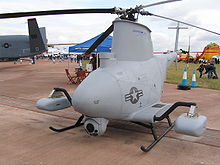Classification
UAVs typically fall into one of six functional categories (although multi-role airframe platforms are becoming more prevalent):
- Target and decoy – providing ground and aerial gunnery a target that simulates an enemy aircraft or missile
- Reconnaissance – providing battlefield intelligence
- Combat – providing attack capability for high-risk missions (see Unmanned combat air vehicle)
- Logistics – delivering cargo
- Research and development – improve UAV technologies
- Civil and commercial UAVs – agriculture, aerial photography, data collection
The U.S. Military UAV tier system is used by military planners to designate the various individual aircraft elements in an overall usage plan.
Vehicles can be categorised in terms of range/altitude. The following has been advanced as relevant at industry events such asParcAberporth Unmanned Systems forum:
- Hand-held 2,000 ft (600 m) altitude, about 2 km range
- Close 5,000 ft (1,500 m) altitude, up to 10 km range
- NATO type 10,000 ft (3,000 m) altitude, up to 50 km range
- Tactical 18,000 ft (5,500 m) altitude, about 160 km range
- MALE (medium altitude, long endurance) up to 30,000 ft (9,000 m) and range over 200 km
- High-Altitude Long Endurance (high altitude, long endurance – HALE) over 30,000 ft (9,100 m) and indefinite range
- Hypersonic high-speed, supersonic (Mach 1–5) or hypersonic (Mach 5+) 50,000 ft (15,200 m) or suborbital altitude, range over 200 km
- Orbital low earth orbit (Mach 25+)
- CIS Lunar Earth-Moon transfer
- Computer Assisted Carrier Guidance System (CACGS) for UAVs
Other categories include:
-
Hobbyist UAVs – which can be further divided into
- Ready-to-fly (RTF)/Commercial-off-the-shelf (COTS)
- Bind-and-fly (BNF) – that require minimum knowledge to fly the platform
- Almost-ready-to-fly (ARF)/Do-it-yourself (DIY) – that require significant knowledge to get in the air.
- Midsize military and commercial drones
- Large military-specific drones
- Stealth combat drones
Classifications according to aircraft weight are quite simpler:
- Micro air vehicle (MAV) – the smallest UAVs that can weight less than 1g.
- Miniature UAV (also called SUAS) – approximately less than 25 kg.
- Heavier UAVs.
Hobbyist UAVs – which can be further divided into
- Ready-to-fly (RTF)/Commercial-off-the-shelf (COTS)
- Bind-and-fly (BNF) – that require minimum knowledge to fly the platform
- Almost-ready-to-fly (ARF)/Do-it-yourself (DIY) – that require significant knowledge to get in the air.




No comments:
Post a Comment